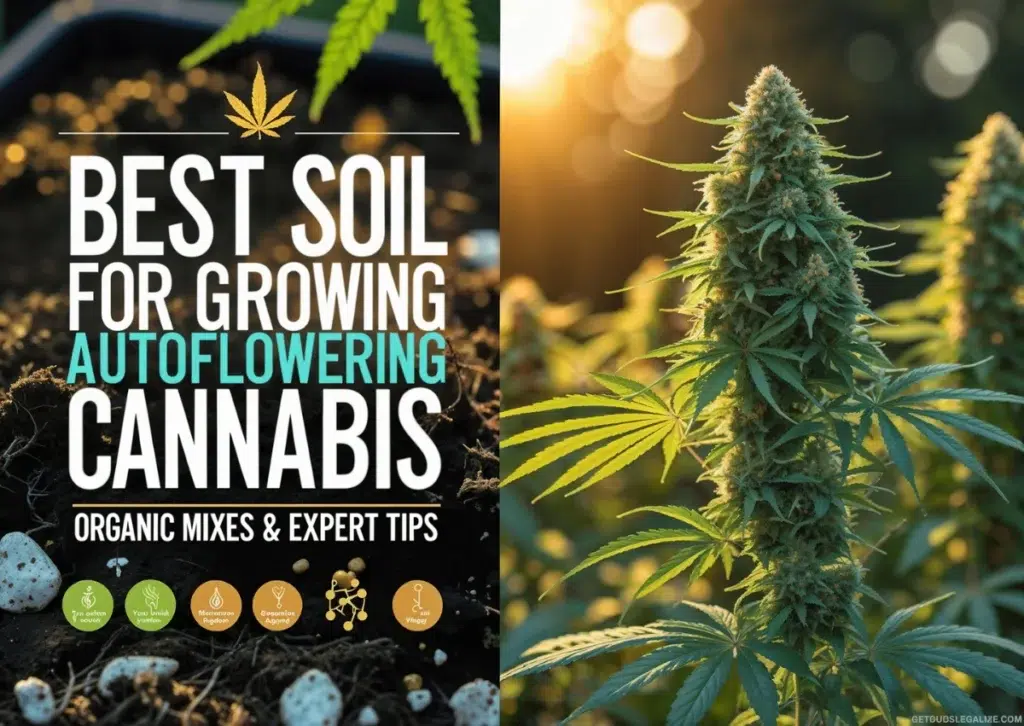General Cannabis Feeding Schedule: What and When to Feed Your Plants
If you want to grow healthy and potent cannabis plants, you need to provide them with the right nutrients at the right time. Cannabis plants have different nutritional needs depending on their stage of growth, their environment, and their strain.
In this blog post, we will discuss the essential nutrients required by cannabis plants and highlight the distinctions between organic and chemical nutrients. Additionally, we will provide guidance on selecting the optimal nutrient product for your cannabis plants while addressing common issues that may arise during the feeding process and how to address them proactively.
What Are The Main Nutrients That Cannabis Plants Need?
Cannabis plants need three main nutrients: nitrogen (N), phosphorus (P), and potassium (K). These are also known as macronutrients or NPK. These nutrients are essential for the growth, development, and flowering of cannabis plants.
Nitrogen is responsible for the green color of the leaves and stems, and it helps with photosynthesis and protein synthesis. Phosphorus is important for the root development, energy transfer, and flowering of cannabis plants. Potassium is involved in water regulation, enzyme activation, and sugar production.
What Are The Secondary and Micronutrients That Cannabis Plants Need?
Besides NPK, cannabis plants also need some secondary nutrients and micronutrients. These are also called trace elements or microelements. These nutrients are needed in smaller amounts, but they are still important for the health and quality of cannabis plants.
Some of the secondary nutrients are calcium (Ca), magnesium (Mg), and sulfur (S). Calcium is important for cell wall structure and stability, magnesium is essential for chlorophyll production and photosynthesis, and sulfur is involved in amino acid and protein synthesis.
Some of the micronutrients are iron (Fe), zinc (Zn), molybdenum (Mo), copper (Cu), manganese (Mn), boron (B), and chlorine (Cl). Iron is important for chlorophyll formation and oxygen transport. Manganese is involved in enzyme activation and photosynthesis. Zinc is essential for hormone production and growth regulation. Copper is important for enzyme activation and pigment formation. Boron is involved in cell division and sugar transport. Molybdenum is essential for nitrogen fixation and metabolism, and Chlorine is involved in water regulation and photosynthesis.
What Are The Differences Between Organic and Chemical Nutrients?
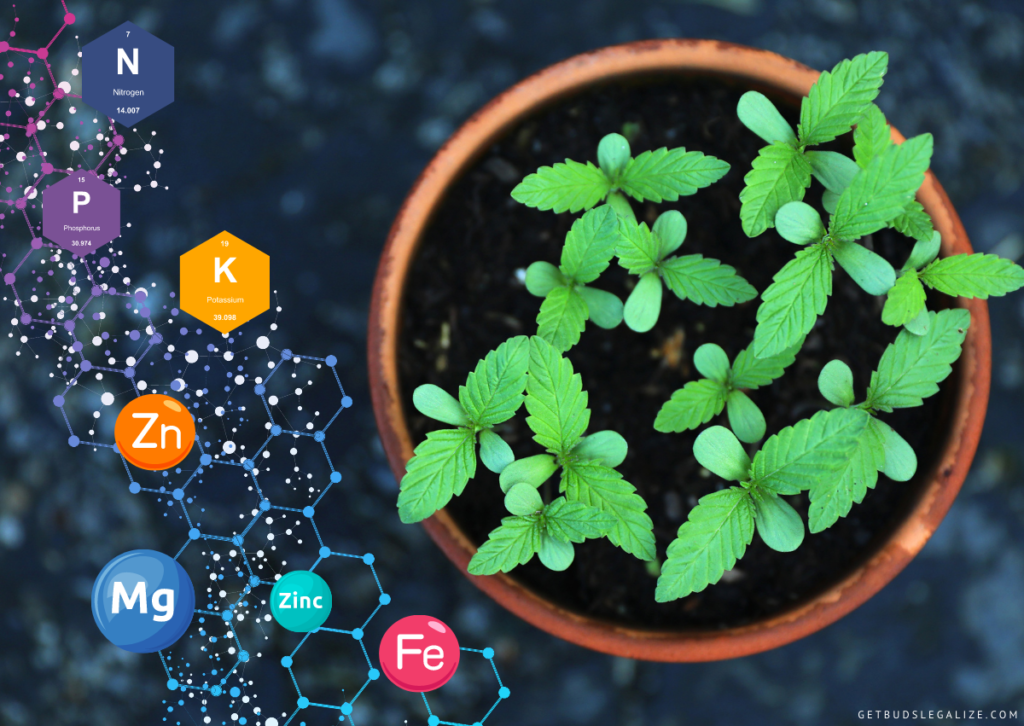
Organic nutrients are derived from natural sources, such as compost, worm castings, bat guano, fish meal, bone meal, kelp, molasses, etc. They are usually mixed with soil or water and applied to the plants.
Nutrients derived from organic sources are rich in micronutrients and beneficial microorganisms that improve soil quality and plant health. They also enhance the flavor and aroma of your buds, as well as their medicinal properties.
Chemical nutrients are synthetic substances that are formulated to provide the exact amount of macronutrients (nitrogen, phosphorus, potassium) and micronutrients (calcium, magnesium, iron, etc.) that your plants need. They are usually dissolved in water and applied to the plants through a drip system or a spray bottle.
Chemical nutrients are easy to use and measure, and they can boost the growth and yield of your plants. However, they can also cause nutrient burn, salt buildup, pH imbalance, and environmental pollution if not used properly.
How Do I Choose The Right Nutrient Product for My Plants?
There are many cannabis nutrients available on the market, each with its own formula, dosage, and application method. To choose the right one for your plants, you need to consider several factors, such as:
- The type of growing medium you are using (soil, coco coir, hydroponics, etc.)
- The stage of growth your plants are in (vegetative or flowering)
- The strain of cannabis you are growing (indica, sativa, hybrid)
- The quality and quantity of water you have access to
- The pH level of your water and soil
- The climate and temperature of your growing environment
- Your budget and personal preference
As a general rule of thumb, you should look for cannabis nutrients that are specifically designed for cannabis plants, that have a balanced N-P-K ratio (nitrogen-phosphorus-potassium), that contains micronutrients and trace elements, that are compatible with your growing medium and water source, that is easy to use and adjust, and that has positive reviews from other growers.
When Do I Start Feeding My Cannabis Plants?
The answer to this question depends on the type of growing medium you are using. If you are using soil that is already fertilized or enriched with organic matter, you don’t need to feed your cannabis plants until they show signs of nutrient deficiency or hunger. This can happen after 3-4 weeks of growth or when the leaves start to turn yellow or pale.
If you are using soil that is poor or depleted in nutrients, you need to start feeding your cannabis plants as soon as they develop their first true leaves (the ones with serrated edges). You should start with a low dose (about 1/4 of the recommended amount) and gradually increase it as your plants grow bigger and stronger.
If you are using coco coir or hydroponics as your growing medium, you need to feed your cannabis plants from day one. Coco coir and hydroponics do not contain any nutrients by themselves, so you need to provide them through a nutrient solution. You should start with a low dose (about 1/4 of the recommended amount) and gradually increase it as your plants grow bigger and stronger.
How Often Do I Feed My Plants?
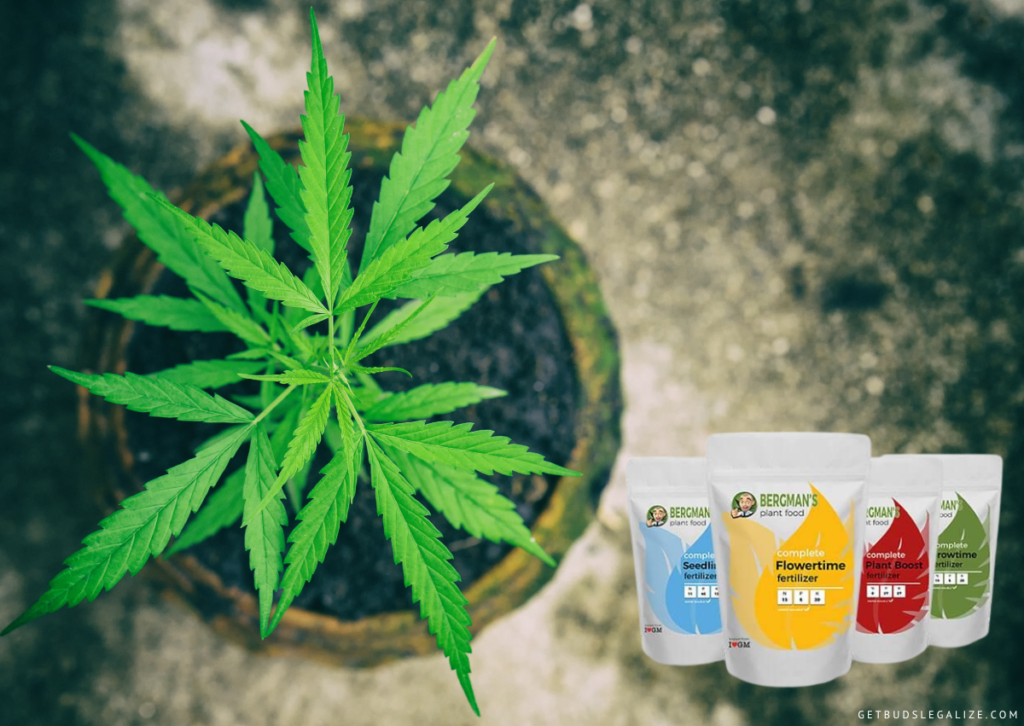
The frequency of feeding your cannabis plants depends on several factors, such as:
- The type of growing medium you are using.
- The type of nutrient product you are using.
- The stage of growth your plants are in.
- The size and health of your plants.
- The climate and temperature of your growing environment.
To provide guidance, it’s recommended to follow these general rules:
- Hydroponics: add nutrients every time you add water to your reservoir or system. You should change the nutrient solution every 1-2 weeks to prevent salt buildup and nutrient lockout.
- Fertilized soil: add nutrients every 1-2 weeks, depending on the strength and quality of your soil. You should flush your soil with plain water every 4-6 weeks to prevent salt buildup and nutrient lockout.
- Poor soil: add a nutrient solution every week, depending on the strength and quality of your soil. You should flush your soil with plain water every 4-6 weeks to prevent salt buildup and nutrient lockout.
How Do I Adjust The Feeding Schedule for Different Stages of Growth?
As you can see from the general cannabis feeding schedule above, you need to adjust the amount and ratio of nutrients you give to your plants depending on their stage of growth. Cannabis plants have different nutritional needs during their vegetative and flowering stages.
During the vegetative stage, cannabis plants need more nitrogen than phosphorus and potassium. Nitrogen is essential for the growth of leaves, stems, and branches. It also helps your plants develop a strong and healthy root system. A good N-P-K ratio for the vegetative stage is 3-1-2 or 4-2-3.
During flowering, cannabis plants need more phosphorus and potassium than nitrogen. Phosphorus is essential for the development of buds, flowers, and resin glands. It also helps your plants resist diseases and pests. Potassium is essential for the transport of sugars, starches, and other nutrients within your plants. It also helps your plants cope with stress and environmental changes. A good N-P-K ratio for the flowering stage is 1-3-2 or 2-4-3.
You can find nutrient products that are specially formulated for each stage of growth, or you can use a balanced N-P-K product and adjust it accordingly.
General Cannabis Feeding Schedule Basics:
To give you a general idea of how to feed your cannabis plants, we have created a simple feed chart that you can follow or modify according to your specific needs and preferences. This schedule is based on a 12-week cycle, from seedling to harvest, using a balanced N-P-K nutrient product. You can adjust the dosage and frequency of feeding depending on the factors we mentioned above.
General Cannabis Feeding Schedule:
| Week | Grow stage | Nutrient Requirements |
| 1 | Seedling | Use plain water or a very low dose of nutrients (about 1/4 of the recommended amount) |
| 2 | Seedling | Use plain water or a very low dose of nutrients (about 1/4 of the recommended amount) |
| 3 | Vegetative | Use a low dose of nutrients (about 1/2 of the recommended amount) |
| 4 | Vegetative | Use a low dose of nutrients (about 1/2 of the recommended amount) |
| 5 | Vegetative | Use a medium dose of nutrients (about 3/4 of the recommended amount) |
| 6 | Vegetative | Use a medium dose of nutrients (about 3/4 of the recommended amount) |
| 7 | Flowering | Use a high dose of nutrients (about the full recommended amount), with more phosphorus and potassium than nitrogen |
| 8 | Flowering | Use a high dose of nutrients (about the full recommended amount), with more phosphorus and potassium than nitrogen |
| 9 | Flowering | Use a high dose of nutrients (about the full recommended amount), with more phosphorus and potassium than nitrogen |
| 10 | Flowering | Use a high dose of nutrients (about the full recommended amount), with more phosphorus and potassium than nitrogen |
| 11 | Flowering | Use a low dose of nutrients (about 1/2 of the recommended amount), with more phosphorus and potassium than nitrogen |
| 12 | Flowering | Stop feeding your plants and flush them with plain water for the last week before harvest |
How Do I Know If My Plants Need More or Less Nutrients?
The best way to know if your cannabis plants need more or less nutrients is to observe their appearance and behavior. Some signs that your plants need more nutrients include:
- Pale green or yellow leaves
- Purple stems
- Small or thin leaves
- Slow or stunted growth
- Low yield or quality
Some signs that your plants need less nutrients include:
- Dark green or purple leaves
- Burnt or curled leaf tips
- Droopy or clawed leaves
- Reduced growth or yield
Should I Use Supplements and Additives for My Plants?
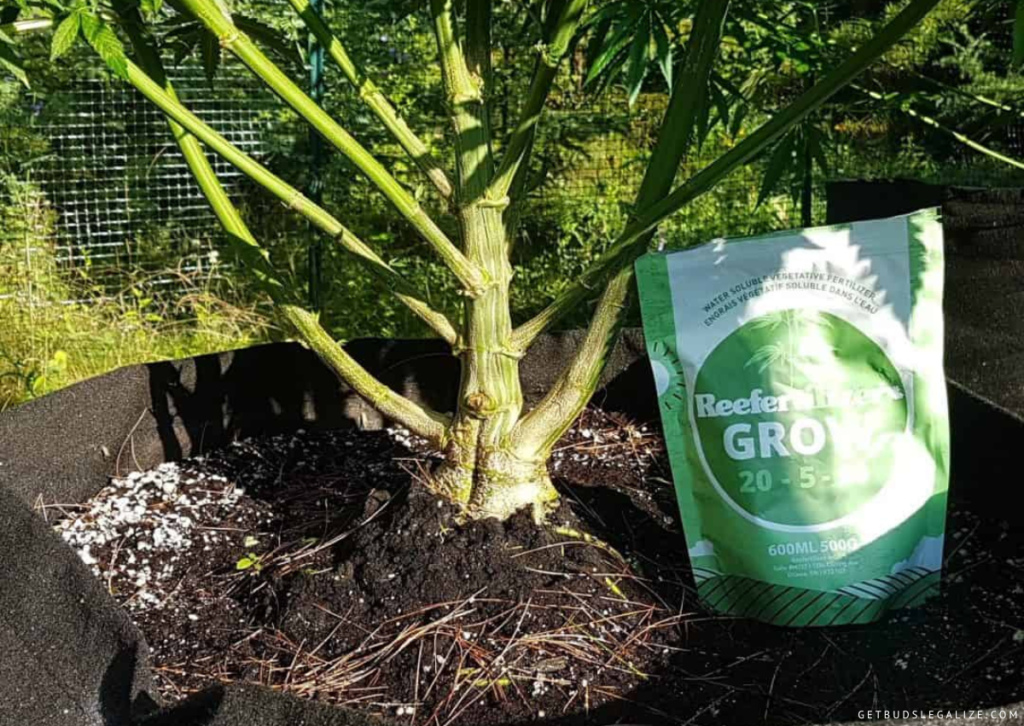
Supplements and additives are products that can enhance the growth and performance of your cannabis plants but are not essential for their survival. They can provide extra benefits such as boosting the immune system, increasing the yield, improving the flavor, or enhancing the potency of your buds.
However, they can also be expensive, complicated, or unnecessary, depending on your situation and goals. Some common types of supplements and additives for cannabis plants are:
1• Amino Acids:
Amino acids are the building blocks of proteins, which are essential for cannabis metabolism and quality. They are synthesized from nitrogen sources in the soil or air, or recycled from old plant tissues. Amino acids play important roles in enzyme production, photosynthesis, respiration, defense, and signaling. Some examples of amino acids involved in cannabis biochemistry are glutamine, asparagine, arginine, proline, and tryptophan.
How and when to use them:
Amino acids can be applied as foliar sprays or soil drenches during vegetative and flowering. They can help improve nutrient uptake, stress tolerance, resin production, and terpene synthesis. However, they should be used with caution as excess amino acids can cause nutrient imbalances or toxicity.
2• Enzymes:
Enzymes are proteins that facilitate chemical reactions in cannabis plants. They help break down organic matter in the root zone, convert sucrose into glucose for energy, and synthesize cannabinoids from precursor molecules. Enzymes are essential for cannabis growth, development, metabolism, and quality. Some examples of enzymes involved in cannabis biosynthesis are sucrose synthase, chitinase, protease, hydrolase, glucanase, cellulase, and THC synthase.
How and when to use them:
Enzymes can be added to the soil or water to improve the decomposition of organic matter, increase the availability of nutrients, and enhance microbial activity. They can also help prevent salt buildup, root rot, and nutrient lockout. Enzymes can be used throughout the entire growth cycle but are especially beneficial during the transition and flowering.
3• Hormones:
Hormones play a crucial role in regulating several aspects of plant development and growth. They are produced naturally by the plant or introduced externally through supplements. Some examples of hormones that affect cannabis plants are auxins, cytokinins, gibberellins, ethylene, and abscisic acid.
How and when to use them:
Hormones can be used to manipulate the shape, size, and flowering time of your cannabis plants. For example, auxins can promote rooting, cytokinins can stimulate branching, gibberellins can increase stem elongation, ethylene can induce flowering, and abscisic acid can enhance drought resistance. However, hormones should be used sparingly and carefully as they can also cause unwanted side effects such as abnormal growth, reduced yield, or hermaphroditism.
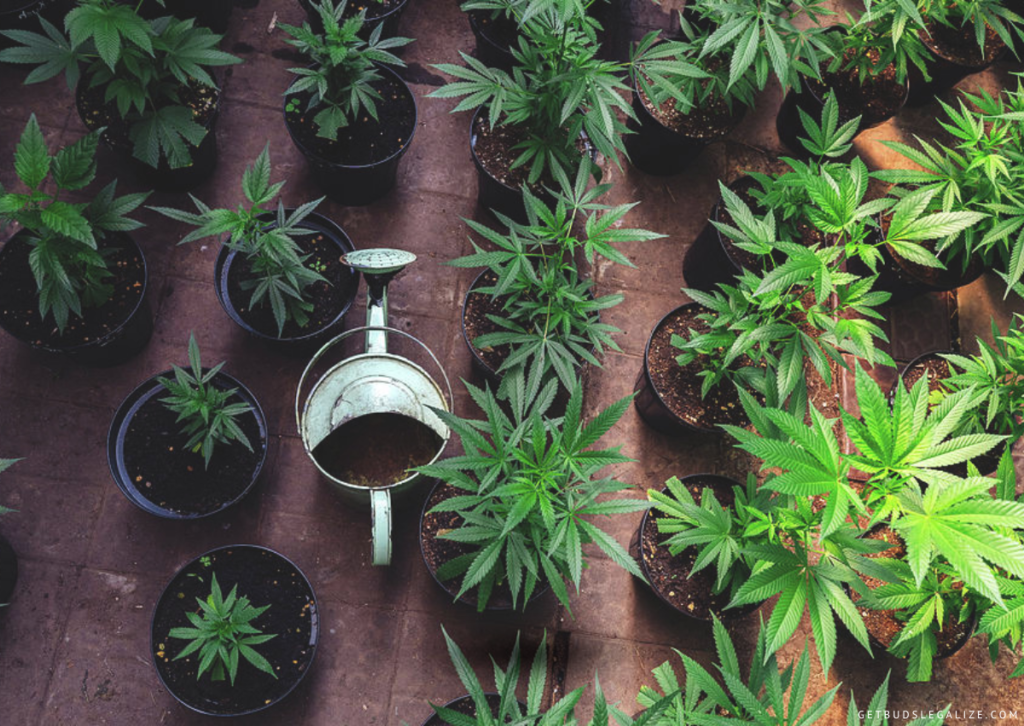
4• Humic and Fulvic Acids:
Humic and fulvic acids are organic compounds derived from decomposed plant and animal matter. They act as natural chelators that bind to minerals, making them more available for plant uptake. They also improve soil structure, water retention, microbial activity, and root health.
How and when to use them:
Humic and fulvic acids can be added to your soil or water throughout the entire life cycle of your cannabis plants. They can enhance the efficiency and effectiveness of your base nutrients and supplements. However, they should be used in moderation as too much humic or fulvic acid can lower the pH of your soil or water and interfere with nutrient absorption.
5• Beneficial Bacteria and Fungi:
Beneficial bacteria and fungi are microorganisms that live in symbiosis with your cannabis plants. They help break down organic matter, fix nitrogen, solubilize phosphorus, produce enzymes, hormones, vitamins, and antibiotics. They also protect your plants from pathogens, pests, and environmental stress.
How and when to use them:
Beneficial bacteria and fungi can be introduced to your soil or water through inoculants such as compost tea, mycorrhizae, trichoderma, bacillus subtilis, etc. They can be applied at any stage of your cannabis cultivation but are especially beneficial during the seedling and transplanting stages. They can boost the growth rate, health, and yield of your plants.
6• Carbohydrates:
Carbohydrates are organic molecules composed of oxygen, hydrogen, and carbon. They serve as the main source of energy for plants and animals. They are classified into simple sugars (such as glucose and fructose) and complex sugars (such as starch and cellulose).
How and when to use them:
Carbohydrates can be added to your soil or water during the flowering to provide extra energy for bud formation. They can also improve the taste and aroma of your buds by increasing the sugar content. However, they should not be overused as too much carbohydrates can cause fungal infections or attract pests.

7• Vitamins:
Vitamins are organic compounds that act as coenzymes or antioxidants in cannabis plants. They are obtained from the environment or synthesized by the plant itself. Vitamins help improve cannabis resistance and vitality by enhancing cellular functions, protecting against oxidative stress, and modulating gene expression. Some examples of vitamins involved in cannabis health are vitamin C, vitamin E, vitamin B1, vitamin B6, and vitamin K.
How and when to use them:
Vitamins can be added to your soil or water throughout the entire life cycle of your cannabis plants. They can improve the overall health and vitality of your plants by enhancing their immune system, photosynthesis, respiration, and stress resistance. However, they should be used appropriately as too many vitamins can cause toxicity or deficiency symptoms.
8• Cal-Mag:
Cal-Mag is a combination of calcium (Ca) and magnesium (Mg), two essential macronutrients for cannabis plants. Calcium is important for cell wall structure, membrane stability, and signal transduction. Magnesium is the central atom of chlorophyll, the green pigment that captures light energy for photosynthesis.
How and when to use them:
Cal-Mag can be added to your soil or water during the vegetative and flowering to prevent or correct calcium and magnesium deficiencies. These deficiencies are common in cannabis plants grown in coco coir, hydroponics, or hard water. They can cause symptoms such as leaf curling, yellowing, wilting, or stunted growth. However, Cal-Mag should be used in moderation as too much calcium and magnesium can interfere with the uptake of other nutrients such as iron, zinc, or manganese.
9• Silica:
Silica is a form of silicon (Si), a beneficial element for cannabis plants. Silicon is not considered an essential nutrient but it can enhance the strength and resilience of your plants. It can improve the cell wall rigidity, stem thickness, leaf stiffness, and root mass of your plants.
How and when to use them:
Silica can be added to your soil or water during the vegetative and flowering to increase the resistance of your plants to pests, diseases, drought, heat, cold, and mechanical stress. It can also improve the quality and potency of your buds by increasing the trichome density and terpene production. However, silica should be used carefully as too much silica can raise the pH of your soil or water and reduce the availability of other nutrients.
Whether you should use supplements and additives for feeding cannabis plants depends on several factors such as:
- Your budget: Supplements and additives can be costly compared to basic fertilizers.
- Your experience: Supplements and additives can be complex to use correctly.
- Your goals: Supplements and additives can be unnecessary if you are satisfied with your results.
- Your preference: Supplements and additives can be personal choices based on trial and error.
If you decide to use supplements and additives, you should always follow the manufacturer’s instructions carefully. You should also start with low doses and gradually increase them as needed.
What Are Some Common Problems That Can Occur When Feeding Cannabis Plants and How to Fix Them?
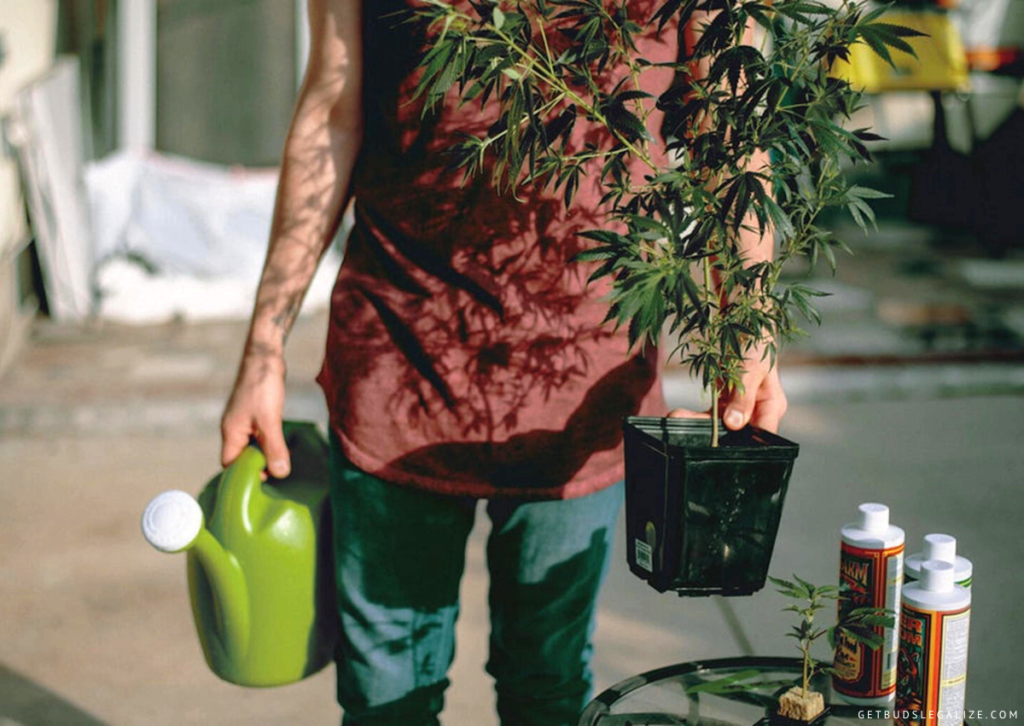
Feeding cannabis plants is not an exact science, and sometimes things can go wrong. Some common problems that can occur when growing cannabis plants are:
1. Nutrient Deficiency:
This happens when your plants do not get enough of one or more nutrients they need. The symptoms vary depending on which nutrient is lacking, but they usually include yellowing, browning, curling, wilting, or dropping of leaves; stunted growth; reduced yield; poor bud development; etc.
To prevent nutrient deficiency, you need to use a balanced fertilizer that contains all the essential nutrients for cannabis plants, such as nitrogen, phosphorus, potassium, calcium, magnesium, sulfur, iron, zinc, copper, manganese, boron, and molybdenum.
You also need to monitor the soil or water quality and adjust the pH and EC levels accordingly. To fix nutrient deficiency, you need to identify which nutrient is missing and supplement it with a suitable product. You can use a nutrient deficiency chart to help you diagnose the problem.
2. Nutrient Toxicity:
This happens when your plants get too much of one or more nutrients they need. The symptoms are similar to nutrient deficiency, but they usually affect the tips and edges of the leaves first. They may also include dark green or purple leaves; burnt or crispy leaf tips; reduced growth; poor bud quality; etc.
To prevent nutrient toxicity, you need to follow the instructions on the fertilizer label and avoid overfeeding your plants. You also need to flush your plants regularly with plain water to remove any excess salts or nutrients from the soil or water.
To fix nutrient toxicity, you need to stop feeding your plants for a while and flush them with plain water until the symptoms subside. You can also use a product that contains enzymes or beneficial bacteria to help break down the excess nutrients.
3. PH Imbalance:
This happens when the acidity or alkalinity of the soil or water is too high or too low for your plants. The ideal pH range for cannabis plants is between 6.0 and 7.0 for soil and between 5.5 and 6.5 for hydroponics. If the pH is out of this range, your plants will have trouble absorbing the nutrients they need and may show signs of nutrient deficiency or toxicity.
To prevent pH imbalance, you need to test the pH of your soil or water regularly and adjust it with pH up or down products as needed. You also need to use a pH buffer that helps maintain a stable pH level in your medium.
To fix the pH imbalance, you need to flush your plants with water that has the correct pH level and add a pH buffer to your medium.
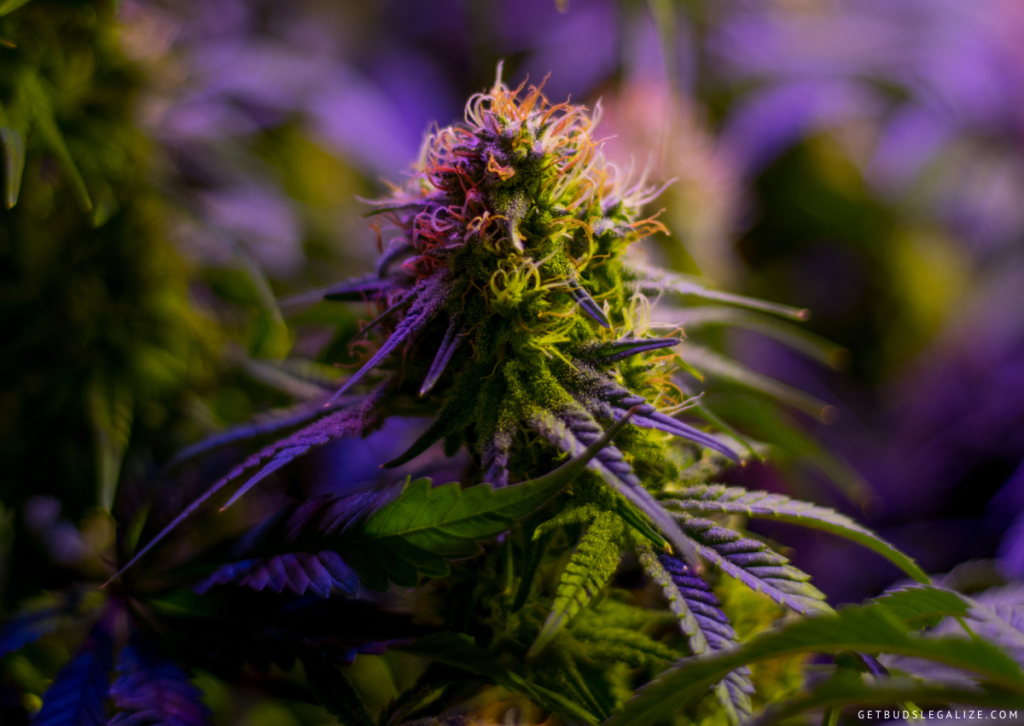
4. Overwatering or Underwatering:
This happens when you give your plants too much or too little water. Both conditions can cause stress and damage to your plants and affect their growth and yield. Overwatering can cause root rot, fungal infections, oxygen deprivation, nutrient leaching, etc. Underwatering can cause wilting, drooping, dehydration, nutrient lockout, etc.
To prevent overwatering or underwatering, you need to check the moisture level of your soil or water by feeling it with your fingers or using a moisture meter. You also need to water your plants according to their size, stage of growth, temperature, humidity, etc.
To fix overwatering or underwatering, you need to adjust the frequency and amount of water you give your plants and make sure they have good drainage and aeration.
5. Salt Buildup:
This happens when the salts from the fertilizer accumulate in the soil or water over time and create a crust on the surface or clog the roots. This can cause a nutrient lockout, pH imbalance, reduced water uptake, etc.
To prevent salt buildup, you need to use organic fertilizers that are less likely to leave behind salts or synthetic fertilizers that are low in salt content. You also need to flush your plants with plain water every few weeks to wash away any excess salts from the medium.
To fix salt buildup, you need to flush your plants with plain water until the runoff is clear and add some organic matter or humic acid to your medium to improve its texture and nutrient retention.
6. Nutrient Burn:
This happens when the concentration of nutrients in the soil or water is too high for your plants and causes damage to their cells. The symptoms are similar to nutrient toxicity but more severe and irreversible. They include yellowing, browning, curling, wilting, dropping of leaves; stunted growth; reduced yield; poor bud development; etc.
To prevent a nutrient burn, you need to use a mild fertilizer that is suitable for cannabis plants and dilute it according to the label instructions. You also need to start with a low dose and gradually increase it as your plants grow and show signs of hunger.
To fix nutrient burn, you need to stop feeding your plants and flush them with plain water until the symptoms stop worsening. You may also need to prune off the damaged leaves and buds to help your plants recover.
7. Nutrient Lockout:
This happens when your plants are unable to absorb the nutrients they need due to various factors such as pH imbalance, salt buildup, overwatering, underwatering, etc. The symptoms are similar to nutrient deficiency but more widespread and persistent. They include yellowing, browning, curling, wilting, dropping of leaves; stunted growth; reduced yield; poor bud development; etc.
To prevent a nutrient lockout, you need to avoid the factors that cause it and follow the best practices for feeding cannabis plants as mentioned above.
To fix nutrient lockout, you need to identify and correct the underlying cause and flush your plants with plain water or a solution that has the correct pH and EC levels.

Bottom Line
Feeding cannabis plants is an important aspect of growing high-quality buds. However, it is not a one-size-fits-all process. You should always tailor your feeding schedule to suit your specific strain, growing medium, environment, and goals. You should also experiment with different products and methods to find what works best for you.
Remember that less is more when it comes to feeding cannabis. It is better to underfeed them than to overfeed them. It is also better to use organic or natural fertilizers than synthetic or chemical ones.
We hope this blog post has given you some useful tips and insights on how to feed your cannabis plants properly. Feeding cannabis is a skill that requires patience, observation, and adaptation. By following the guidelines we have provided, you can improve your chances of growing healthy, potent, and flavorful buds.
Thank you for reading this blog post. Happy growing!
FAQs
There is no definitive answer to this question, as different types of nutrient products have their own advantages and disadvantages. The best type of nutrient product for cannabis plants depends on your personal preference, budget, experience level, growing medium, growing method, plant stage, plant strain, etc. Some popular types of nutrient products for cannabis plants include:
- Liquid fertilizers: these are easy to use and absorb, but they may also be expensive and prone to salt buildup.
- Dry fertilizers: these are cheap and long-lasting, but they may also be hard to dissolve and measure.
- Organic fertilizers: these are natural and eco-friendly, but they may also be slow-releasing and inconsistent.
- Chemical fertilizers: these are precise and fast-acting, but they may also be harsh and unnatural.
The best way to know if your cannabis plants have a nutrient deficiency or toxicity is to identify which nutrient is affected and what symptoms it causes. Some common nutrients that affect cannabis plants and their symptoms include:
- Nitrogen (N) – essential for vegetative growth; deficiency causes yellowing of lower leaves, stunted growth, and reduced branching; toxicity causes dark green leaves, clawing, and reduced bud development.
- Phosphorus (P) – essential for flowering, root development, and energy transfer; deficiency causes dark green or purple leaves, slow growth, and small buds; toxicity causes brown spots on leaves and reduced iron uptake.
- Potassium (K) – essential for photosynthesis, water regulation, and stress resistance; deficiency causes yellowing or browning of leaf edges, curling, and wilting; toxicity causes leaf tip burn and nutrient lockout.
- Calcium (Ca) – essential for cell wall structure, enzyme activity, and nutrient transport; deficiency causes distorted or necrotic leaves, stunted growth, and blossom end rot; toxicity causes reduced magnesium uptake and leaf tip burn.
- Magnesium (Mg) – essential for chlorophyll production, enzyme activity, and sugar synthesis; deficiency causes yellowing of lower leaves with green veins, curling, and reddening of stems; toxicity causes reduced calcium uptake and leaf tip burn.
Other micronutrients such as iron, sulfur, copper, manganese, and zinc are also important for cannabis plants but are needed in smaller amounts. Deficiencies or toxicities of these nutrients can cause various symptoms such as chlorosis, necrosis, interveinal yellowing, stunted growth, leaf curling, etc.
The easiest way to adjust the pH level is to use a pH adjuster product. A pH adjuster product is a liquid or powder that either lowers or raises the pH level of a liquid when added to it. You can buy these products online or at any gardening store. You should follow the instructions on how to use them and test the pH level before and after adding them.
The General Hydroponics Flora Series is a liquid nutrient system formulated for growing and flowering cannabis plants that can be customized for different stages of plant growth. It consists of three formulas: FloraMicro, FloraBloom, and FloraGro.
- FloraMicro provides nitrogen, calcium, and trace minerals.
- FloraBloom supplies phosphorus, potassium, magnesium, and sulfate.
- FloraGro supports vegetative growth with nitrogen, potassium, magnesium, and sulfate.
To use the Flora Series, you need to follow the feeding chart and schedule provided by General Hydroponics. For autoflowering plants grown in soil, you can use a lower concentration of nutrients and a less frequent feeding schedule than for other plants.
To use it, you need to dilute it with water according to the instructions on the label. Then, you can apply it to your plants either by watering them or by spraying them with a fine mist. It can be used for all types of plants, indoors or outdoors, in soil or hydroponics. It can improve the growth, yield, and quality of your crop
ILGM Fertilizer

- From seedling to harvest, give your plants everything they need.
- Enough for feeding at least 5 plants.
- Discounted Package Deal
- Works well in soil, hydroponics, and other growing mediums.
- The best way to treat your plants
ILGM Plant Protector

- Protect your cannabis from diseases and harmful pests.
- Contains three 20 ml bottles.
- Enough supplies to protect 20 plants.
- It can be used in soil, hydroponic, and all other growing mediums.













